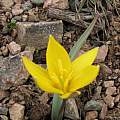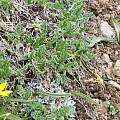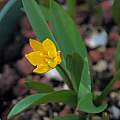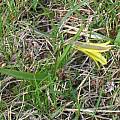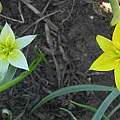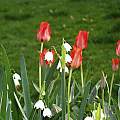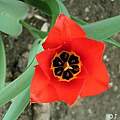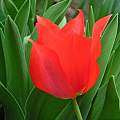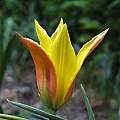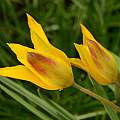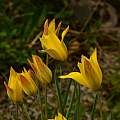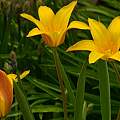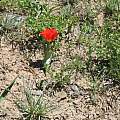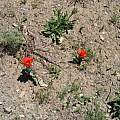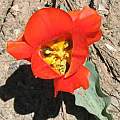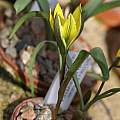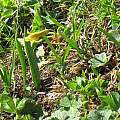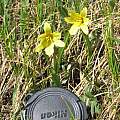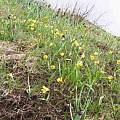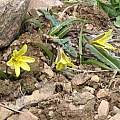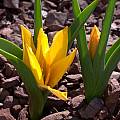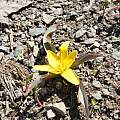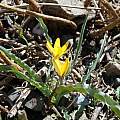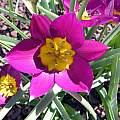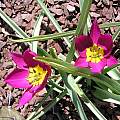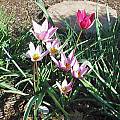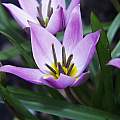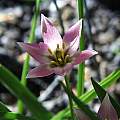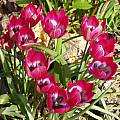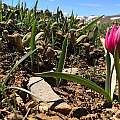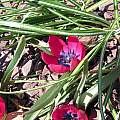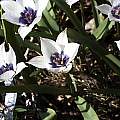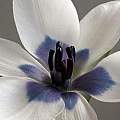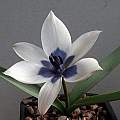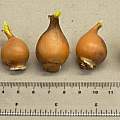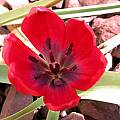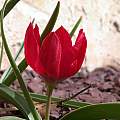Tulipa is a genus in the Liliaceae family from Europe, western Asia to central Asia and North Africa. There are about 100 species and thousands of cultivars. A book written in 2006 by Richard Wilford is a good source of information. Tulipa species d-h are found on this wiki page
Tulipa hybrids - Tulipa a-c - Tulipa i-r - Tulipa s-z - Tulipa index
Tulipa dasystemon (Regel) Regel is distributed in Kazakhstan, Kyrgyzstan, Central Asia to northwestern China. Photos by David Victor where it was growing in the wild on the eastern Tien Shan mountains, Kazakhstan, in June 2004 on the Talgar Pass at about 9,000 feet. The second picture shows Tulipa dasystemon (on the left) growing with Tulipa heterophylla (on right).
A species, Tulipa neustruevae Pobed., is now considered to be a synonym of Tulipa dasystemon. Found at a lower elevation in the western Tien Shan, it is a brighter golden yellow and has fresh glossy green leaves. It can be grown in a rock garden or raised bed and flowers March to April. Photo taken in a Portland, Oregon, garden March 2009 by Mary Sue Ittner.
Tulipa dasystemonoides Vved. is considered in 2021 by some but not all authorities to be a synonym of Tulipa dasystemon. It differs mainly in the tunication having a leathery bulb tunic and occasionally two flowers per stem. Photographs by David Victor taken at the Ulkun-Kyindi Pass at roughly 9,000 feet growing in the wild in the western Tien Shan mountains, Kazakhstan, in July 2004.
Tulipa edulis (Miq.) Baker see Amana edulis (Miq.) Honda
Tulipa eichleri Regel is considered to be a synonym of Tulipa undulatifolia var. undulatifolia by some authorities in 2021. It is from Turkey, Iran, and Greece. It is widely bell-shaped with bright scarlet flowers with yellow margins and a dark basal blotch. The first photo by Arnold Trachtenberg. The other photos from Janos Agoston.
Tulipa ferganica Vved. is distributed in Central Asia where it grows on bare rocky hillsides. Growing from 15 to 25 cm tall, it has glaucous wavy-edged leaves and bright golden yellow flowers blushed darker on the outside. Grown in New Jersey, photos by Arnold Trachtenberg.
Tulipa fosteriana W.Irving is a robust species from Central Asia where it is found in deep, humus-filled pockets among rocks at altitudes of around 1700 m. It has broad leaves and large red flowers, often lined with black. It has been used in breeding of many garden cultivars, including these groups: Darwin Hybrid Group, Kaufmanniana Group, Greigii Group, and the group that most closely resembles this species, the Fosteriana Group.
Tulipa greigii Regel is distributed from Iran to Central Asia. It grows 20 to 45 cm tall with gray green leaves striped and dotted with purple or brown and solitary widely cupped flowers usually red or yellow with a blackish yellow margined eye in the center. Photos by David Victor of plants growing in the wild on the western Tien Shan mountains, Kazakhstan, in June 2004. The photographs were taken in the Ulkun-Kyindi valley at roughly 9,000 feet. The plants were growing on a hot dry bank, above the other species tulips which were growing in the bottom of the valley. Greig's tulip was named in 1873 after Samuil Alexeevich Greig (1827-1887) who was a Russian General, Finance Minister, onetime President of the Russian Horticultural Society, and grandson of Admiral Samuel Greig (1735-1788, "Father of the Russian Navy") by Eduard August von Regel (1815-1892), director of the St Petersburg Botanical Garden (see Gartenflora 22: 290 (1873)). Some of the cultivars in the Greigii Group can be seen on our hybrid tulips page.
Tulipa heteropetala Ledeb. is a tulip native to Iran, Afghanistan, Pakistan (Chitral), Kazakhstan, and into Russia. Growing from 10 to 11 cm with bulbs that are hairy at the tip, it has pale yellow flowers described as marked violet on the outside. It is in the subgenus Orithyia along with Tulipa heterophylla and Tulipa uniflora. Photos taken by Ettrig in Göteborgs Botaniska Trädgård in Gothenburg, Sweden and shared here under the CC BY-SA 4.0 license.
Tulipa heterophylla (Regel) Baker is distributed in Southern Kazakhstan, Kyrgyzstan, and northwestern China. Growing 5 to 12 cm tall, it has small yellow flowers stained green or purple on the outside and glabrous bulb tunics. It is in the subgenus Orithyia along with Tulipa heteropetala and Tulipa uniflora. Photos by David Victor taken where it was growing in the wild on the eastern Tien Shan mountains, Kazakhstan, in June 2004. The first two shots were taken near a redundant Russian space centre at some 11,000 feet, whilst the other two were taken in the Talgar Pass at roughly 9,000 feet. The second shot includes a lens hood for size comparison. They are small plants! The third shot clearly shows the density of plants on the mountain side.
Tulipa hissarica Popov & Vved. is from the Hissar Range in Tajikistan and Uzbekistan. It appears soon after snow melts at high elevations, differs from T. dasystemon by having 4 undulate leaves, usually with red margins. First photo by John Lonsdale; photos 2 and 3 were taken in its habitat in Tajikistan by Oron Peri.
Tulipa humilis Herb. is a species from Turkey, Azerbaijan, Lebanon, Syria, Iraq, and Iran that is variable in color and size with petal blotches from black to blue to yellow. It grows on rocky slopes in high altitudes often near the snowline. A number of names have been published for the various forms, but there is great variation in the wild and now most authorities list those named species as Tulipa humilis with four of them named as varieties. The typical form, Tulipa humilis var. humilis first described by Herbert is a dwarf tulip with lilac pink to rose flowers with a yellow base and yellow filaments and anthers. The flowers have a sweet yet peculiar clay-like earthen scent. The first two photos from John Lonsdale. The fourth photo by Mark McDonough shows flowers grown from Dutch bulb stock available at garden nursery centers in the fall. In the photograph, one plant has much darker red-rose flowers. The last photo was taken by Arnold Trachtenberg.
The other varieties are:
Tulipa humilis var. aucheriana (Baker) Christenh., syn. Tulipa aucheriana Baker, is from Iran and Syria where it is found on rocky mountain sides. It has small pink, starry flowers with a less defined yellow blotch. It can still be found commercially under the name of Tulipa aucheriana and under that name received a RHS award of garden merit. Photo below from Arnold Trachtenberg who purchased it under the previous name and gardens in New Jersey.
Tulipa humilis var. kurdica (Wendelbo) Christenh. is from Turkey and has brick red flowers.
Tulipa humilis var. pulchella (Fenzl ex Regel) Christenh., syn. Tulipa pulchella (Fenzl ex Regel) Baker, is from Turkey and has falcate leaves and purplish crimson flowers with a blue-black blotch on a white background. You often see bulbs sold as Tulipa pulchella var. violacea with characteristics of both varieties. Photo by Dave Brastow from a plant that has been thriving in Tumwater, Washington. The flowers are borne on 15 cm stems, but only open fully in bright sunlight. The second photo taken by abdullah ünlü and shared under a CC BY-SA 3.0 license.
Tulipa humilis var. violacea (Boiss. & Buhse) Christenh. has violet to deep purplish crimson flowers with a black blotch and purple or black filaments. It is found in Azerbaijan and Iran. Photos by John Lonsdale resemble this variety.
Tulipa humilis 'Alba Coerulea Oculata' is a cultivar (with a name often seen with different spellings including 'Albocaerulea-oculata', 'Albocoerulea Oculata', 'Albo-caerulea Occulata') that is white with a steel blue base. Jane McGary mentions it is said to have been collected (as a clone) in 1927, in mountainous northwestern Iran. Diana Everett, in 'The Genus Tulipa', writes that it is "best grown under glass." I suspect that is to give it a dry summer in England, Everett's home. It grew well outdoors in the foothills of the Cascade mountains, northwestern Oregon, with frequent frost and some winter snow. Photo 1 by Arnold Trachtenberg. Photos 2-3 by Ian Young.
Tulipa humilis 'Eastern Star' is magenta-rose with a bronze-green flame and a canary-yellow base. The first two photos of it are from David Pilling of a bulb and the resulting plants in spring. Tulipa humilis 'Lilliput' is red with a violet base and more than one flower per stem. The third and fourth photo of it from John Lonsdale.
Tulipa hybrids - Tulipa a-c - Tulipa i-r - Tulipa s-z - Tulipa index
